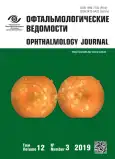New algorithm for planning superior tarsal muscle resection for blepharoptosis: description of technique and results
- Authors: Potyomkin V.V.1,2, Goltsman E.V.3
-
Affiliations:
- Pavlov First Saint Petersburg State Medical University
- City Multi-Field Hospital No. 2
- City Ophthalmologic Center of City hospital N 2
- Issue: Vol 12, No 3 (2019)
- Pages: 83-90
- Section: In ophthalmology practitioners
- URL: https://journals.rcsi.science/ov/article/view/16049
- DOI: https://doi.org/10.17816/OV16049
- ID: 16049
Cite item
Abstract
Background. Transconjunctival techniques for blepharoptosis correction are popular because of ease of implementation and good predictability. For a long time, the phenylephrine test remained the main factor influencing the choice of blepharoptosis correction method. Recently, more and more researches indicate the possibility of the superior tarsal muscle resection in patients with negative responses to the phenylephrine test. Authors have proposed and described a new modified technique for resection of the superior tarsal muscle, which can be used to correct blepharoptosis in patients with different responses to phenylephrine test.
Materials and methods. The study included 2 groups of patients with mild to moderate blepharoptosis with levator muscle function 8 mm or more. The main group (75 patients, 103 eyelids) underwent a modified resection of the superior tarsal muscle, and in the comparison group (26 patients, 35 eyelids) an open sky resection of the superior tarsal muscle was performed. Surgery in the main group was planned according to the following algorithm. In positive and sufficient response to the test, 2/3 of the superior tarsal muscle was resected. In case of positive but insufficient response to the phenylephrine test, subtotal superior tarsal muscle resection was performed. In case of negative or slightly positive result of phenylephrine test, an assessment of the white line motility was additionally performed intraoperatively. If the motility of the white line (in mm) was equal to the amount of ptosis, subtotal superior tarsal muscle resection was performed without resection of the superior tarsal plate. If the motility of the white line was less than desired amount of correction, then subtotal superior tarsal muscle resection was combined with tarsal plate resection to reach the desired amount of correction. The residual height of the tarsal plate was always left 5 mm or more. If superior tarsal plate was compromised or not high enough to perform desired amount of resection then white line was advanced to the tarsal plate.
Results. The degree of ptosis, the result, the width of the palpebral fissure in the center, lateral and medial limbus, MRD 1 and MRD 2 did not significantly differ between the groups (p > 0.05). However, the frequency of hypo- and hypercorrections was significantly lower in the main group (p < 0.05).
Conclusion. New algorithm of planning modified superior tarsal muscle resection gives an opportunity to use transconjuctival methods of blepharoptosis correction in cases of weak and negative phenylephrine test and to reduce the amount of hypo- and hypercorrections
Full Text
##article.viewOnOriginalSite##About the authors
Vitaly V. Potyomkin
Pavlov First Saint Petersburg State Medical University; City Multi-Field Hospital No. 2
Email: ageeva_elena@inbox.ru
PhD, Assistant Professor. Department of Ophthalmology
Russian Federation, 197089, St. Petersburg, Lev Tolstoy str., 6-8, building 16; 194354, St. Petersburg, Uchebniy pereulok, 5Elena V. Goltsman
City Ophthalmologic Center of City hospital N 2
Author for correspondence.
Email: ageeva_elena@inbox.ru
ophthalmologist
Russian Federation, 194354, St. Petersburg, Uchebniy pereulok, 5References
- Ben Simon GJ, Lee S, Schwarcz RM, et al. External levator advancement vs Müller’s muscle-conjunctival resection for correction of upper eyelid involutional ptosis. Am J Ophthalmol. 2005;140(3):426-432. https://doi.org/10.1016/j.ajo.2005. 03.033.
- Blaskovics L. Treatment for ptosis: formation of a fold in the eyelid and resection of the levator and tarsus. Arch Ophthalmol. 1929;1(6):672-680. https://doi.org/10.1001/archopht. 1929.00810010698002.
- Custer PL. Ptosis: levator muscle surgery and frontalis suspension. In: Chen WP, eds. Oculoplastic surgery: the essentials. New York: Thieme; 2001. P. 89-100.
- Finsterer J. Ptosis: causes, presentation, and management. Aesthetic Plast Surg. 2003;27(3):193-204. https://doi.org/10.1007/s00266-003-0127-5.
- Fox SA. Surgery of ptosis. Archives of Ophthalmology. 1980; 98(1):186. https://doi.org/10.1001/archopht.1980.01020030188025.
- Ben Simon GJ, Lee S, Schwarcz RM, et al. Müller’s muscle-conjunctival resection for correction of upper eyelid ptosis: relationship between phenylephrine testing and the amount of tissue resected with final eyelid position. Arch Facial Plast Surg. 2007;9(6): 413-417. https://doi.org/10.1001/archfaci.9.6.413.
- Putterman AM, Urist MJ. Müller muscle-conjunctiva resection. Technique for treatment of blepharoptosis. Arch Ophthalmol. 1975;93(8):619-623. https://doi.org/10.1001/archopht.1975.01010020595007.
- Baldwin HC, Bhagey J, Khooshabeh R. Open sky Müller muscle-conjunctival resection in phenylephrine test-negative blepharoptosis patients. Ophthalmic Plast Reconstr Surg. 2005;21(4):276-280. https://doi.org/10.1097/01.iop.0000167789.39570.3e.
- Lake S, Mohammad-Ali FH, Khooshabeh R. Open sky Müller’s muscle-conjunctiva resection for ptosis surgery. Eye (Lond). 2003;17(9):1008-1012. https://doi.org/10.1038/sj.eye.6700623.
- Peter NM, Khooshabeh R. Open-sky isolated subtotal Müller’s muscle resection for ptosis surgery: a review of over 300 cases and assessment of long-term outcome. Eye (Lond). 2013;27(4):519-524. https://doi.org/10.1038/eye.2012.303.
- Malhotra R, Patel V. Transconjunctival blepharoptosis surgery: a review of posterior approach ptosis surgery and posterior approach white-line advancement. Open Ophthalmol J. 2010;4(1): 81-84. https://doi.org/10.2174/1874364101004010081.
- Putterman AM, Fett DR. Müller’s muscle in the treatment of upper eyelid ptosis: a ten-year study. Ophthalmic Surg. 1986;17(6): 354-360.
- Weinstein GS, Buerger GF Jr. Modification of the Müller’s muscle-conjunctival resection operation for blepharoptosis. Am J Ophthalmol. 1982;93(5):647-651. https://doi.org/10. 1016/s0002-9394(14)77383-0.
- Dresner SC. Further modifications of the Müller’s muscle-conjunctival resection procedure for blepharoptosis. Ophthalmic Plast Reconstr Surg. 1991;7(2):114-122. https://doi.org/10.1097/00002341-199106000-00005.
- Mercandetti M, Putterman AM, Cohen ME, et al. Internal levator advancement by Müller’s muscle-conjunctival resection: technique and review. Arch Facial Plast Surg. 2001;3(2):104-110. https://doi.org/10.1001/archfaci.3.2.104.
- Perry JD, Kadakia A, Foster JA. A new algorithm for ptosis repair using conjunctival Müllerectomy with or without tarsectomy. Ophthalmic Plast Reconstr Surg. 2002;18(6):426-429. https://doi.org/10.1097/00002341-200211000-00007.









